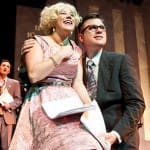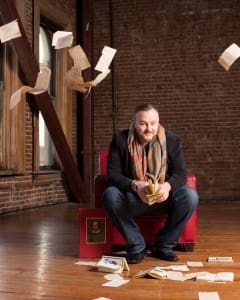- Skip to primary navigation
- Skip to secondary navigation
- Skip to main content
- Skip to primary sidebar
Spoof, Parody, Satire – A B&B Christmas
October 28, 2014

A Miracle on 43rd Street – Director’s Notes
It’s a parody…a spoof, a send-up, a mockery, a lampoon…But it is also a burlesque, pastiche, caricature and a satire… It’s a B&B Christmas show!
 Over the past seven years, Bag&Baggage has developed a reputation for doing holiday shows that are a little (um, how should I say this….) different from your standard Christmas entertainment. For those of you “old enough to remember,” think back to our very first Christmas show: The Eight:Reindeer Monologues. Yipes. Perhaps a bit too far for our audiences, yes, but thankfully we had 17 inches of snow so most of the people who bought tickets weren’t actually able to attend, which meant I had far fewer angry emails and phone calls to return!
Over the past seven years, Bag&Baggage has developed a reputation for doing holiday shows that are a little (um, how should I say this….) different from your standard Christmas entertainment. For those of you “old enough to remember,” think back to our very first Christmas show: The Eight:Reindeer Monologues. Yipes. Perhaps a bit too far for our audiences, yes, but thankfully we had 17 inches of snow so most of the people who bought tickets weren’t actually able to attend, which meant I had far fewer angry emails and phone calls to return!
But, in our second year, we came back swinging with my very own adaptation of the Dickens’ classic, A Christmas Carol. Told from Dickens’ perspective and highlighting our actors’ ability, with lightning fast skill, to play multiple characters and bring both a farcical sense of humor and a heartwarming sensibility to the old chestnut about Scrooge and the ghosts, A Christmas Carol really cemented B&B’s approach to holiday shows. We had a hit and we were going to pound that formula into the ground if we had to! So, we followed up with The Trial of Ebenezer Scrooge and then Farndale Avenue’s…Christmas Carol, both featuring a small cast playing multiple roles in over-the-top farcical style, and then, last year, the first of three 1940s radio-show style Christmas productions, It’s A (somewhat) Wonderful Life! Miracle on 43rd Street is the second in our planned trilogy of 1940s radio show spoofs.
But why do it this way? Why do over the top, farcical retellings of cherished favorites? Why not just do a more traditional Christmas show? Why, oh why oh why oh why?
John Gross, an English theatre and book critic who was once called “the best-read man in Britain” writes in his Oxford Book of Parodies that when a literary or dramatic formula grows tired (such as in the case of many holiday shows which are great stories, but nonetheless so familiar to us that it is difficult for them to ever be seen as fresh or new), one of the most valuable things that a writer or director can do with that story is to parody it. To parody something, explains Gross, is to take elements of the work out of context and reuse them, not always necessarily with a view towards ridicule. In fact, Gross says, parody can refocus our understanding of the original work, let us see it more clearly, more distinctly; appreciate its strengths, dismiss its flaws, and revel both in originality and in familiarity.
 For me, our approach to holiday shows is far more about how much I love them rather than how much I want to mock them. It is also, in no small way, about bringing a provocative new vision to these classic stories that we know so well; why do we love them, why do they move us, what is it about them that gives them such longevity? By asking these questions, and focusing our work on lampooning the answers, we find new and different ways of showing our love for them. Miracle on 34th Street is no different. It is undeniably a classic; a moving and enduring story of the power of faith, of the magic that is found in childlike wonder, and what happens when we all believe the best of each other…a remarkably timely and appropriate message for this (or any) season.
For me, our approach to holiday shows is far more about how much I love them rather than how much I want to mock them. It is also, in no small way, about bringing a provocative new vision to these classic stories that we know so well; why do we love them, why do they move us, what is it about them that gives them such longevity? By asking these questions, and focusing our work on lampooning the answers, we find new and different ways of showing our love for them. Miracle on 34th Street is no different. It is undeniably a classic; a moving and enduring story of the power of faith, of the magic that is found in childlike wonder, and what happens when we all believe the best of each other…a remarkably timely and appropriate message for this (or any) season.
The 1947 film Miracle on 34th Street won Academy Awards for Best Supporting Acting, Best Writing (Original Story) and Best Writing (Screenplay) and was nominated for Best Picture. It has inspired multiple film remakes (four!), television versions, radio plays and even a 1963 musical version called Here’s Love…the great Richard Attenborough played Kringle in the 1994 feature film and Macy’s Department store in New York has a 30 minute puppet version that they perform in their Santaland event each year…so this sweet and heartwarming tale of the Macy’s Santa who turns out to be the real thing has a long adaptive history.
What I think is so remarkable about the story is that it takes what we know to be true (that there is no such thing as Santa Claus) and makes that the basis of a story about the real Kris Kringle. The genius of Miracle on 34th Street is that the very premise of the story, that Santa isn’t real, is a truth that we all know…but the film asks us to set aside that truth in favor of something else, something far more powerful and potent than truth; hope. We watch as the characters in the story, all of whom know Santa Claus isn’t real, are slowly moved to belief, to wonder, to joy, and to hope. It is a little like theatre, in that way.
You know, as you sit in your comfy seat here in the Venetian, that the actors onstage are not real; they aren’t actually performing a 1940s radio show, those aren’t their real clothes or voices, they aren’t really real…but wouldn’t it be nice if they were? I think I would quite like to live in a world where people like Lana and Winston actually exited, where catastrophes always turn out as happy endings, and where a kindly old gentleman with a white beard turns out to be the real deal…a magical, kind, loving supernatural being who just wants children to be happy. I like that. I like that a lot.
Here is a final tidbit of interest to the academics among you. The very first time the word parody was ever used in the English language was in Ben Jonson’s Elizabethan play Every Man In His Humour, where a character exclaims, “A parody, a parody! To make it even absurder than it was!”
I like that, too. I like that a lot.
Special thanks to Jessi Walters, Pete Schuyler and the irreplaceable Ian Armstrong for their advice and insight into the crafting of this script. Thanks for helping me keep it real, and real silly. Also, very special thanks to Mike and Laura McMurray and the whole team at the Hillsboro Hops who enjoyed their own Miracle this year; a championship!
 Happy holidays from all of us at B&B to you and yours.
Happy holidays from all of us at B&B to you and yours.
Scott Palmer, Artistic Director
